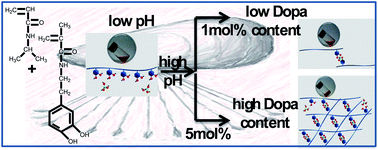Rapid self-healing and triple stimuli responsiveness of a supramolecular polymer gel based on boron–catechol interactions in a novel water-soluble mussel-inspired copolymer†
Abstract
Marine and freshwater mussels secrete proteinaceous adhesive materials for adherence to the substrates upon which they reside. It is well known that 3,4-dihydroxyphenylalanine (DOPA) is the key to understanding these mussel adhesive proteins (MAPs). In order to gain a better understanding of their complex formation and quick recovery upon rupturing, novel water soluble copolymers of N-isopropylacrylamide and dopamine methacrylate were synthesized in such a way that they have 1, 2.5, and 5 mole percent dopamine monomer with respect to the NIPAM monomer on average. The statistical distribution of DOPA-functionalities along the chain makes the material a close synthetic equivalent of the byssal thread proteins of mytili. At acidic pH, the aqueous copolymer solution behaves like an unentangled copolymer solution, but at basic pH, these catechol functionalities form a dicomplex with H3BO3, thereby crosslinking two chains, proven by 11B-NMR and gelation. The polymer solution is thermosensitive with a pH-dependent lower critical solution temperature (LCST) between 21 and 33 °C, depending on the DOPA-content. If 2 or more functionalities per chain are present, a gel is formed that is self-healing with very quick recovery from sustained damage. The moduli of the gels depend on the concentration of functionalities. Hence, triple stimuli responsive copolymers were obtained.


 Please wait while we load your content...
Please wait while we load your content...